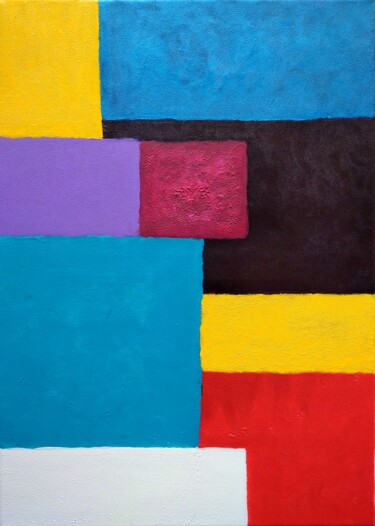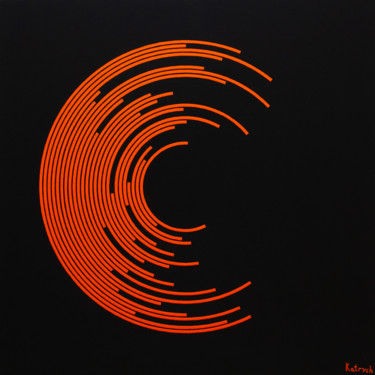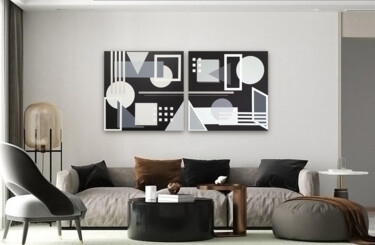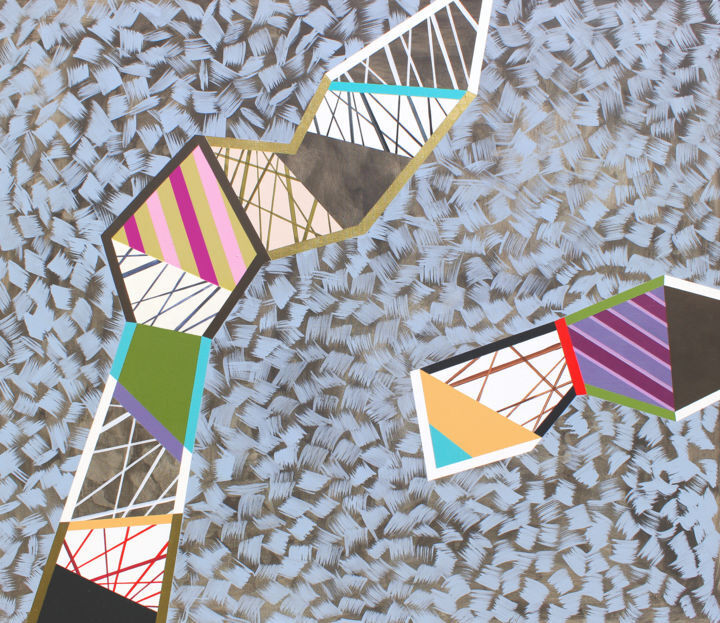 Lucie Jirku, Colour, shape and texture 1, 2020. Acrylic on linen canvas, 130 x 150 cm.
Lucie Jirku, Colour, shape and texture 1, 2020. Acrylic on linen canvas, 130 x 150 cm.
The further it goes, the more scientific the art will be....
"The time for beauty has passed. Mankind, unless it returns to it, does not know what to do with it for more than a quarter of an hour. The further we go, the more scientific art will become, as science will become artistic. Both will unite at the top after separating at the bottom."
These prophetic words, written by Gustave Flaubert in 1852, seem perfect for introducing the essence of the artistic revolution brought about by Geometric abstraction, a movement which, born within Neoplasticism (Netherlands, 1917), identified mathematics and geometry as its points of reference, focusing on the study of numerical relationships and the investigation of proportions and measures between shapes and colors.
 Stanislas Maurer, Blue geometries, 2021. Oil on canvas, 85 x 140 cm.
Stanislas Maurer, Blue geometries, 2021. Oil on canvas, 85 x 140 cm.
 Alessandro Butera, Italian style white and red, 2022. Acrylic and plastic sculpture, 32 x 35 x 25 cm / 2.00 kg.
Alessandro Butera, Italian style white and red, 2022. Acrylic and plastic sculpture, 32 x 35 x 25 cm / 2.00 kg.
But who were the precursors of such innovation?
The artistic investigation of Cezanne and Seurat is credited with having laid the preconditions for the development of Geometric abstraction, since Cezanne created his art by referring to the laws of geometry, while Seurat concentrated on the search for harmony, developing an almost musical perception of reality. Precisely the research of these two artists was at the origin of what would come later, namely Fauvism and Expressionism, the transcendental base of geometric abstraction.
 Selig, Geometric paths 2, 2020. Acrylic on wood, 115 x 115 cm.
Selig, Geometric paths 2, 2020. Acrylic on wood, 115 x 115 cm.
 Luis Medina, Ng 26, 2021. Acrylic on canvas, 70 x 70 cm.
Luis Medina, Ng 26, 2021. Acrylic on canvas, 70 x 70 cm.
Geometric Abstraction
Geometric abstraction, coming after many decades of figurative painting, brought about the introduction of simple geometric figures, which, combined within subjective compositions, were placed in surreal spaces. This new context of artistic investigation, devoid of references to the real world, pursued the goal of declaring that painting is something that is simply done, reacting to the excess of subjectivity and emotionality of the visual artists of previous movements. In fact, geometric abstract art, which sought to always be precise, adhered to the "cold" rules of nature and science. One of the most emblematic pioneers and artists of the aforementioned movement was Kazimir Malevich, who, with his work, and especially with the iconic paintings Black Square (1915) and White on White (1918), innovatively promoted the values of logic, mathematics, and objectivity in the art world. In addition, another transcendental exponent of modern abstract geometric art was Piet Mondrian, who, author of the very famous compositions of compact blue, yellow and red rectangles, made on a white background with primary colors and black and white abstract geometric art, pursued the goal of creating a mix between art, matter and spirit, in order to capture universal harmony and discover the spiritual essence of reality and life. Finally, the third painter who indelibly marked the history of the aforementioned movement was Theo Van Doesburg, whose artistic production was characterized, for a period, by the creation of abstract figurative studies in geometric figures, composed of lines, rectangles and colored squares. Subsequently, the fascination for the purity of geometry and color continued, extending from post-war to contemporary art, through the personal interpretations of masters such as Josef Albers, Robert Delaunay and Sonia Delaunay, Sol LeWitt and Victor Vasarely.
 Dek, The cut, 2016. Wood and metal sculpture, 80 x 80 x 3 cm.
Dek, The cut, 2016. Wood and metal sculpture, 80 x 80 x 3 cm.
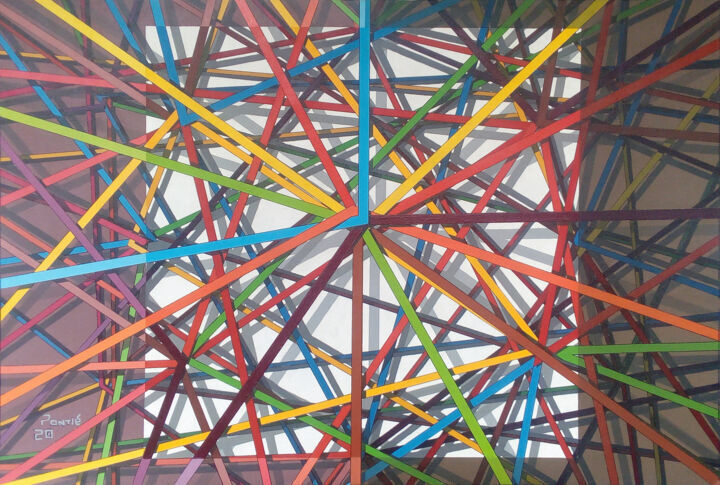 Pontié Stéphane, N°08, 2020. Acrylic on canvas, 80 x 117 cm.
Pontié Stéphane, N°08, 2020. Acrylic on canvas, 80 x 117 cm.
The popularity of Geometric Abstraction in contemporary art
Geometric Abstraction is still very popular today, both in terms of the art scene and the market, as evidenced by the numerous exhibitions dedicated to this movement, organized by the world's most important institutions, museums and galleries. In addition, the aforementioned legendary geometric masters continue to inspire the production of new generations of popular talented creatives such as Sarah Morris, Matteo Nasini, Helen Miranda Wilson and Ricardo Mazal. What's more, geometric abstraction is also gaining ground in street and urban art, as evidenced by the work of Maya Hayuk, Augustine Kofie and Alexey Luka. Thus, in such a splendid variety of styles and approaches, this movement continues to thrive and, judging by its success, will continue to do so.
 Bertrand Bellay, Psychopompe 3, 2018. Acrylic on canvas, 100 x 100 cm.
Bertrand Bellay, Psychopompe 3, 2018. Acrylic on canvas, 100 x 100 cm.
Geometric Abstraction and the Artists of Artmajeur
The contemporary popularity of abstract geometric art, as well as its wealth of approaches and interpretations, has also captured the attention of the artists of Artmajeur, who have produced both totally new and experimental pieces and original interpretations of past masterpieces. The works that, inspired by the great classics, have provided a new and modern point of view on them are, for example, Ohne titel by Gerd Aupke, Black square by Van Lanigh and Optical groovy hippie hipster retro vintage spin abstract by Tony Rubino.
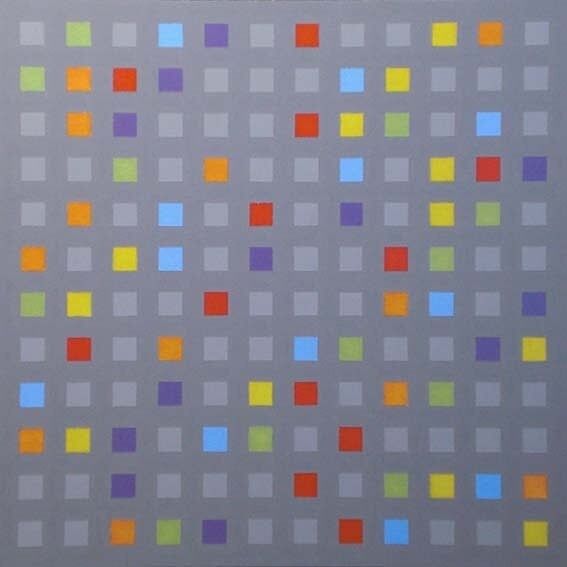 Gerd Aupke, Ohne titel, 1997. Acrylic on canvas, 50 x 50 cm.
Gerd Aupke, Ohne titel, 1997. Acrylic on canvas, 50 x 50 cm.
Gerd Aupke: Ohne titel
Aupke's painting represents an accurate study of the geometric figure of the square, which is investigated both in the format of the canvas and in the subjects multiplied within it. From a chromatic point of view, instead, the small red, yellow, blue, green, orange and violet squares, which are arranged on the surface, probably have the purpose of exalting the study of geometry, contrasting the flattening and monotony of a prevalent grey scale. This type of artistic investigation, having as its subject the seriality of the figure of the square, seems to represent a sort of modern reinterpretation of the painting Composition with color fields by Piet Mondrian. In reality, however, within the work of the Dutch master we also find depicted incomplete rectangles and squares, while the geometric research of the artist of Artmajeur turns out to be more precise, accurate and serial.
 Van Lanigh, Black square, 2022. Polymer clay sculpture on canvas, 20 x 20 x 6 cm / 2.00 kg.
Van Lanigh, Black square, 2022. Polymer clay sculpture on canvas, 20 x 20 x 6 cm / 2.00 kg.
Van Lanigh: Black square
Lanigh's sculpture represents a three-dimensional geometric study, where, within a white, square support, multiple black spheres are arranged, capable of reflecting images of the surrounding environment. The title and colors of the work clearly refer to Malevich's iconic and minimalist Black Square, which is reinterpreted with a new richness and complexity. In fact, what remains of the original masterpiece are only the concepts at the base of Lanigh's work: a black square that is grafted onto a white backdrop, also square in shape. Finally, what certainly unites the two artists is the intent to investigate the true essence of art, namely its plastic nature.
 Tony rubino, Optical groovy hippie hipster retro vintage spin, 2022. Acrylic/Lithograph on canvas, 40.6 x 61 cm.
Tony rubino, Optical groovy hippie hipster retro vintage spin, 2022. Acrylic/Lithograph on canvas, 40.6 x 61 cm.
Tony rubino: Optical groovy hippie hipster retro vintage spin
Rubino's painting makes clear reference to the artistic investigation of the founder of Optical art Victor Vasarely and, in particular, to the painting Vega III, preserved at the Guggenheim Museum in New York. Nevertheless, the artist of Artmajeur has developed a very personal effect of two-dimensional illusion, which proves to be more delineated and invasive than the original. What remains of Vasarely's masterpiece are the colors and the concept behind the artistic investigation of Optical art, that is, the chromatic juxtaposition of simple geometric figures, aimed at creating powerful optical illusions, which are capable of inducing a perceptual instability with the maximum involvement for the observer.


 Olimpia Gaia Martinelli
Olimpia Gaia Martinelli












